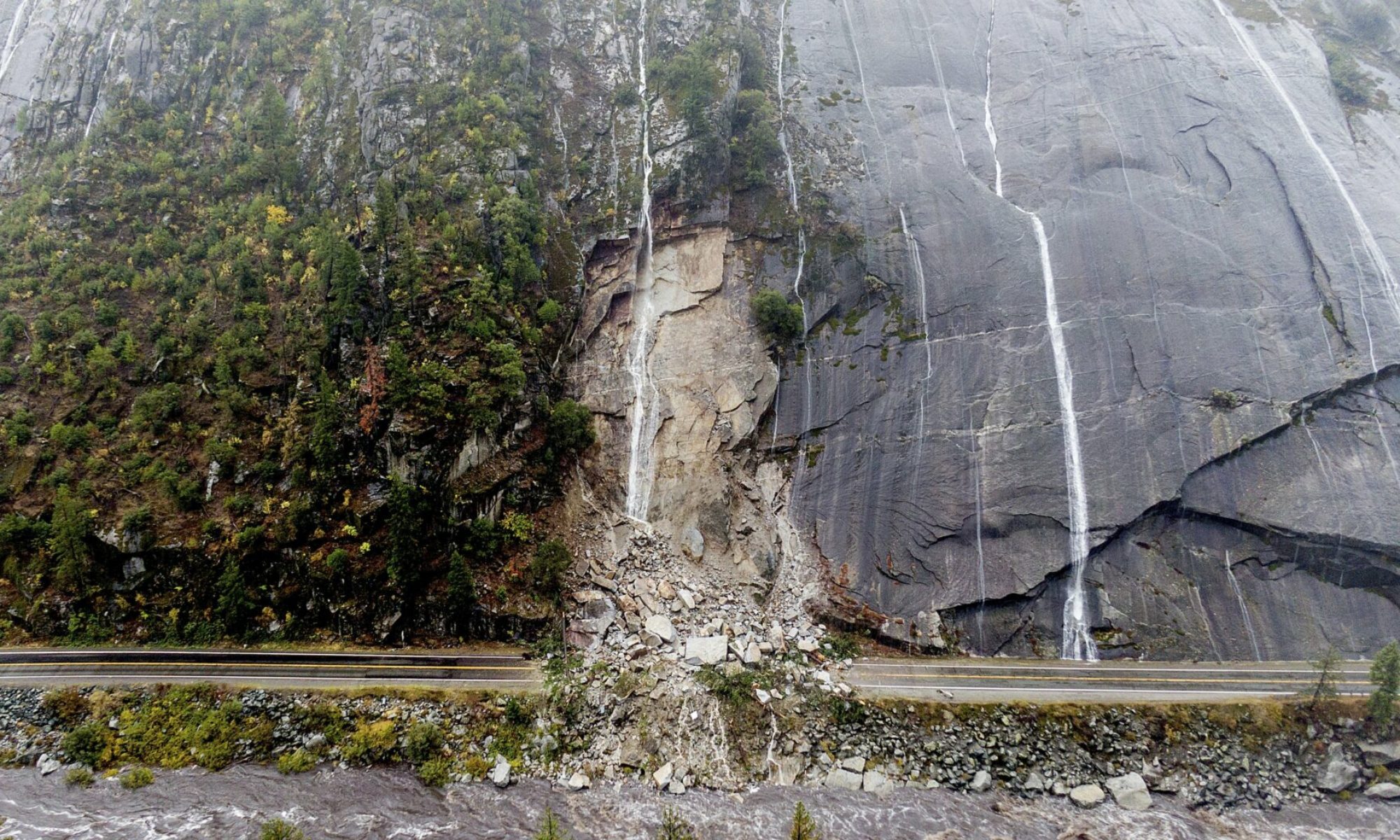Geologists, engineers, and other professionals of earth science often rely on unique and slightly differing definitions of landslides. This diversity in definitions reflects the complex nature of the many disciplines associated with studying landslide phenomena. For our purposes, landslide is a general term used to describe the downslope movement of soil, rock, and organic materials under the effects of gravity and also the landform that results from such movement.
Though there are many classification systems for mass movements, one of the most widely used methods comes from Varnes (1978) (and adapted by Hungr, 2001), which differentiates landslides according to the type of material involved and the mode of movement. 1
This classification method states, in brief, that:
- Material in a landslide mass is either rock or soil (or both). Soil may be described as earth if it is mainly composed of sand-sized or finer particles and debris if composed of coarser fragments.
- The type of movement describes the actual internal mechanics of how the landslide mass is displaced: fall, topple, slide, spread, or flow (which are all individually described below).
- Landslides are thus described using the two terms that refer respectively to material and movement (that is, rockfall, debris flow, and so forth).
Table 1 shows certain types of landslides according to this classification.

- Other classification systems may incorporate additional variables, such as the rate of movement and the water, air, or ice content of the landslide material. §
Falls
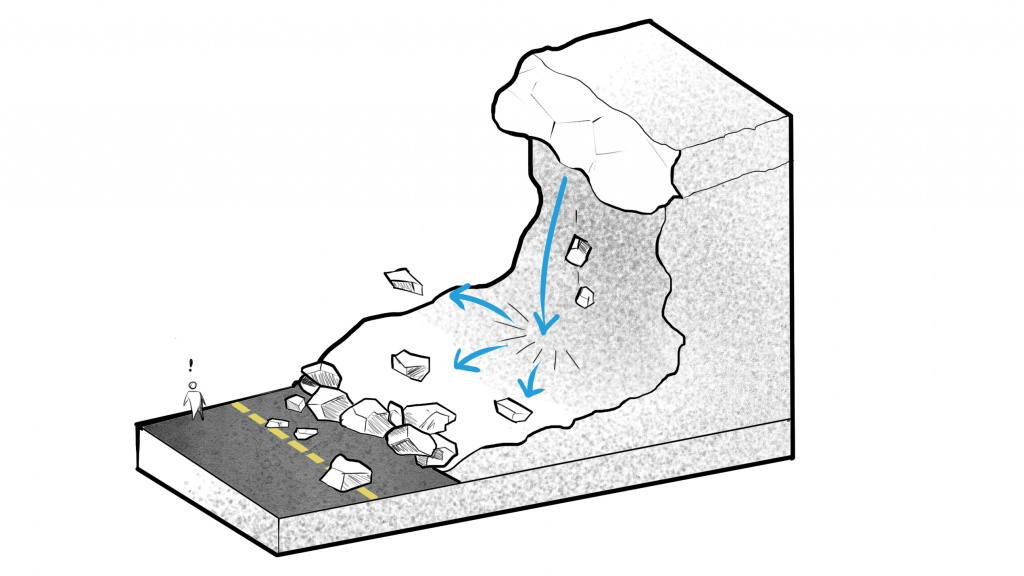
Falls are abrupt movements of masses of geologic materials, such as rocks and boulders, that become detached from steep slopes or cliffs. Separation occurs along discontinuities such as fractures, joints, and bedding planes, and movement occurs by free-fall, bouncing, and rolling.
They commonly happen worldwide anywhere where steep or vertical slopes are present, and more predominantly in coastal areas, along rocky banks of rivers and streams. The volume of material in a fall can vary substantially, from individual rocks or clumps of soil to massive blocks thousands of cubic meters in size.
Triggering mechanisms: Falls are strongly influenced by gravity, mechanical weathering, and the presence of interstitial water. The undercutting of slope by natural processes (including streams and rivers, freeze/thaw cycles, etc.), human activities (such as excavation during road building) and vibration from seismic activities can trigger these types of mass movements.
Mitigation measures: - Rock curtains or other types of slopes covers - Protective covers over roadways - Retaining walls to prevent rolling or bouncing - Rock bolts or other similar types of anchoring used to stabilize cliffs - Warning signs in hazardous areas for awareness.
Topples
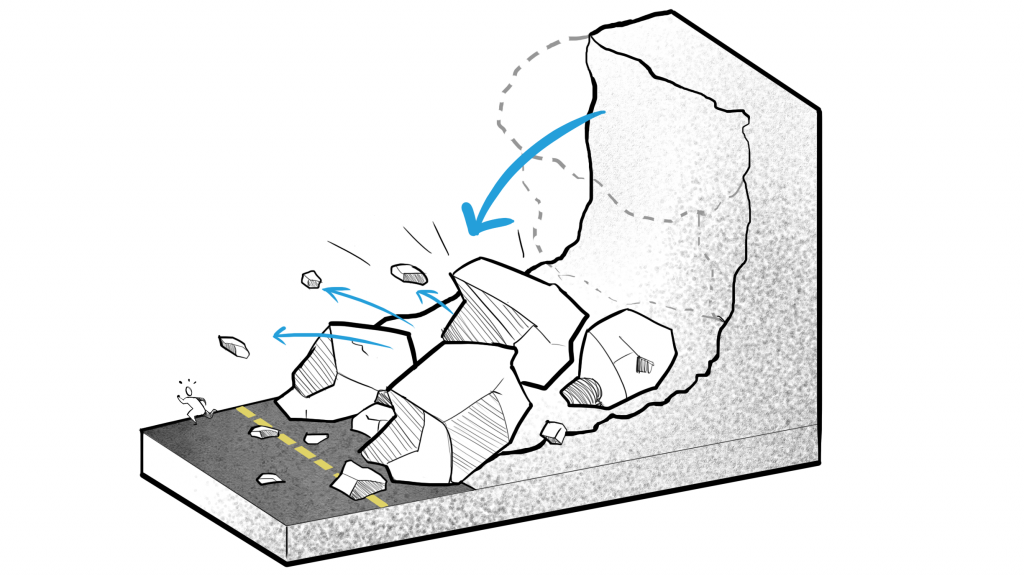
A topple is the forward rotation out of a slope of a mass of soil or rock around a point or axis below the center of gravity of the displaced mass. Topples can consist of any material ranging from rock to finer earth materials, and like falls, are known to occur globally, specifically along stream and river courses where the banks are steep. They can be extremely destructive, especially when failure is sudden and (or) the velocity is rapid.
Triggering mechanisms: Topples are mostly caused by the gravity force exerted by material located upslope from the displaced mass. Excessive vibration, slope undercutting, weathering, excavation, and stream erosion can also provoke topples.
Mitigation measures: Typical slope reinforcement measures, such as rock bolts, retaining walls and other types of anchors are recommended against topples. Because seepage can be an important factor to rock instability, adequate drainage should always be monitored as a preventive measure.
Slides
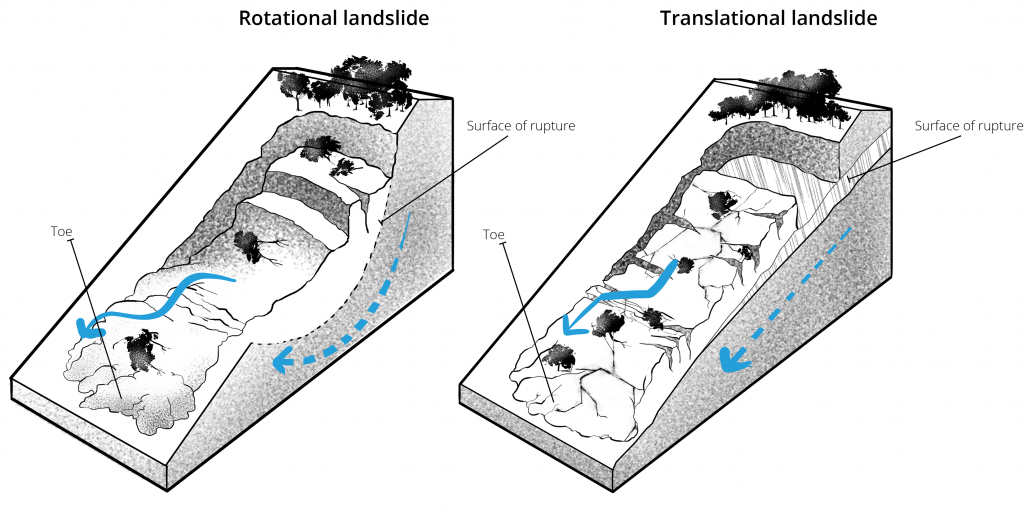
A slide is a downslope movement of a soil or rock mass occurring on surfaces of rupture or on relatively thin zones of intense shear strain. 1
There are two types of slides:
- Rotational slide: a landslide on which the surface of rupture is curved upward (spoon-shaped) and the slide movement is more or less rotational about an axis that is parallel to the contour of the slope. 2
- Translational slide: a landslide where the mass moves along a relatively planar surface.
Slides are one of the most common types of mass movement worldwide and are found globally in all types of environments and conditions. Rotational slides occur especially more frequently in homogenous materials, making them the most common landslide occurring in “fill” materials. Materials involved range from loose earth material to slabs of rocks. Translational slides can be particularly devastating if the surface of rupture is steep, in contrast to rotational slides.
Triggering mechanisms: Water variation is probably the main triggers of slides. Rise in the ground water table due to intense/sustained rainfall, snowmelt, flooding, or other inundation of water resulting from irrigation, or leakage from pipes can all lead to the saturation of the slope and trigger a slide. Undercutting and seismic activity are also among the main triggering mechanisms of both rotational and translational slides.
Mitigation measures: Both translational and rotational slides can be prevented through similar measures. 3 They include: - Adequate grading, drainage and leveling, both to prevent slope failure and to prevent a reactivation of an existing slide. Disrupted drainage pathways should also always be restored or reengineered. - Retaining walls at the toe of the slope. - In rock remedies such as anchors, bolts, and dowels. - Instrumental monitoring, in order to detect the type and rate of movement
- Though it is important to note that movement most often does not initially occur simultaneously over the whole surface of rupture. The volume of displacing material enlarges from an area of local failure in an avalanche effect.
- If the slide is rotational and has several parallel curved planes of movement, it is called a slump.
- Though moderate and steep slopes are very difficult to stabilize permanently.
Spreads
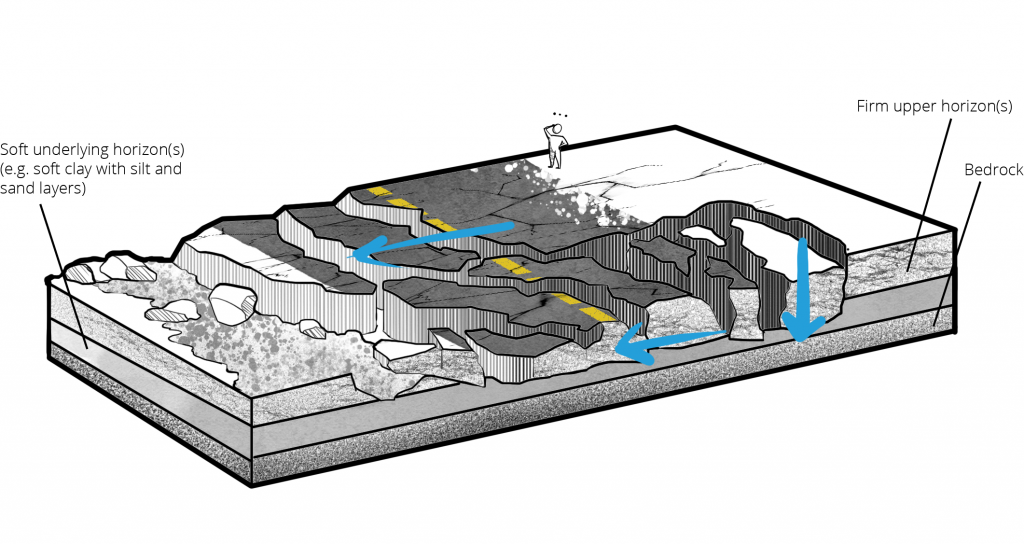
A spread may be defined as the horizontal, or near-horizontal stretching (or elongation) of a cohesive mass of overburden material (rock or soil) (Hungr, 2014). The subsidence of this displaced mass into the softer underlying material is what differentiates a spread from a slide. Common in areas where liquefiable soils exist, as well as in areas of high seismic activity, spreads are usually more limited in terms of total displacement and velocity than other mass movements (except for creep).
Triggering mechanisms: Spreads result from the liquefaction of the softer, weaker underlying material. This can occur due to excessive lubrication of the soil due to precipitation, snowmelt, ground-water changes, or following an erosional disturbance at the base of an important water stream, such as a riverbank. Seismic activity, as well as overloading of an unstable slope (both by natural and anthropologic means) can also trigger spreads.
Mitigation measures: Spreads seem to be harder to prevent and mitigate than other types of mass movements. The best prevention measure is to avoid areas with potentially liquefiable soils as construction sites, which necessitates proper mapping (or inventory) and in-situ vulnerability analyses. Good site drainage and water-diversion strategies can also mitigate the risk of spreads.
Flows
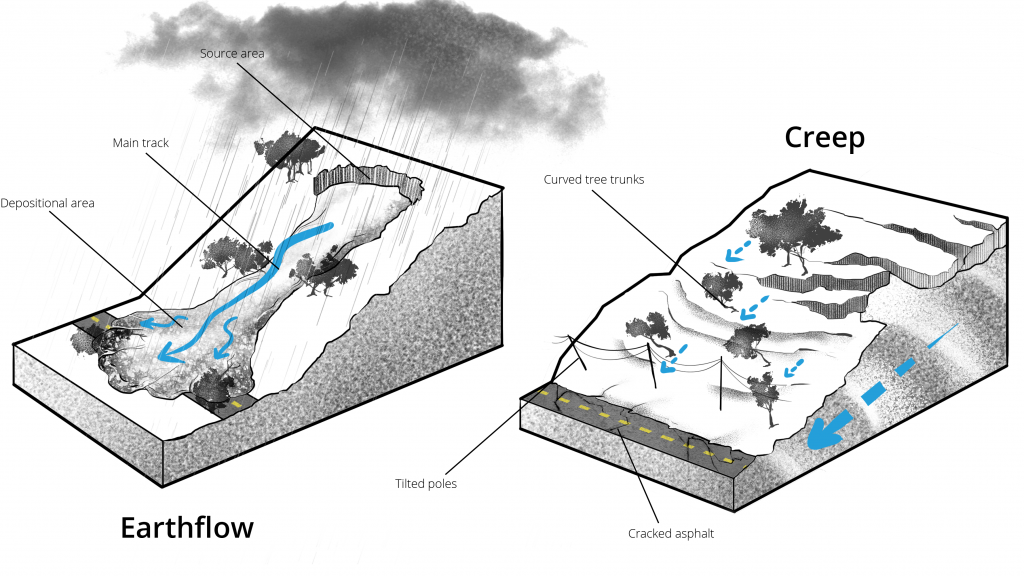
Flows are a somewhat complex mass movement type to define. They are differentiated from a slide due to the water content, the mobility of the material, and the evolution of the movement. Akin to slides, flows are a downslope movement of material due to gravity, but contrarily to the slides, the components velocities within the displaced mass act as a viscous liquid. One can think of a gradation between slides and flows depending on the water content. Slides can even evolve into flows when the displaced, moving mass loses cohesion and mixes with water. 1
Flows are generally considered to be among the most hazardous mass movements due to the velocity of the displaced material, their unpredictability, and the speed at which they can unfold. Debris flows occur all around the world, but most are most prominent in steep gullies, canyons, volcanic areas, and slopes disturbed by wildfires and forest logging. Earthflows occur primarily in regions with weakened (or weathered) bedrocks or where finer grained soils are prevalent in the soil profile, which is the case in many regions of North America. 2 Creep is the most common type of landslide and also occurs globally.
A distinction must be made between certain types of flow:
- Debris flows are made of loose soil, rock and sometimes organic matter combined with water to form a slurry that flows downslope. They are sometimes informally called “mudslides” due to the large quantity of fine material that may be present in the flow.
- Earthflows consists of fine-grained soil particles (like clay or silt) or clay-bearing, very weathered bedrock which move as a plastic or viscous flow. The movement of mass in an earthflow can be very slow (creep) or rapid and catastrophic.
- Creep is the informal name of an earthflow whose movement of displaced mass happens imperceptibly slowly, but steadily, over time. It occurs when the internal shear stress is sufficient to cause movement but is insufficient to provoke the overall failure of the slope.
Triggering mechanisms: Most types of flows are caused by an excess of water in the overburden, resulting in excessive pore-pressure and liquefaction of the material. Intense rainfall or snowmelt can erode and mobilize loose earth material on steep slopes, leading to debris flows. Earth flows are triggered by the same processes, added to slope undercutting, excessive load, human-induced vibrations, and even the sudden lowering of adjacent water bodies, which leads to a rapid depletion of the groundwater table. Creep can be explained via a whole variety of causes which affect all other types of mass movement, added to other triggers such as chemical and physical weathering, poor drainage, etc.
Mitigation measures: Flows can usually not be prevented or predicted. When an area shows a history of debris flows or presents too many risk factors associated with this type of mass movement (susceptible soils, reduced vegetation cover due to wildfires or logging, etc.), it is best to avoid all development activities, to adopt measures of flow deflection towards zones of lesser risks, and to put in place an adequate set of early warning systems to mitigate the losses. As for creeps, proper drainage, grading of slopes, and leveling are among the most important corrective measures.
- In rarer instances, “dry flows” can be possible in the case of slopes made of cohesionless material, such as sand.
- In fact, devastating earthflows have occurred in the susceptible marine clays of the St. Lawrence lowlands in Quebec, as well as in B.C.
